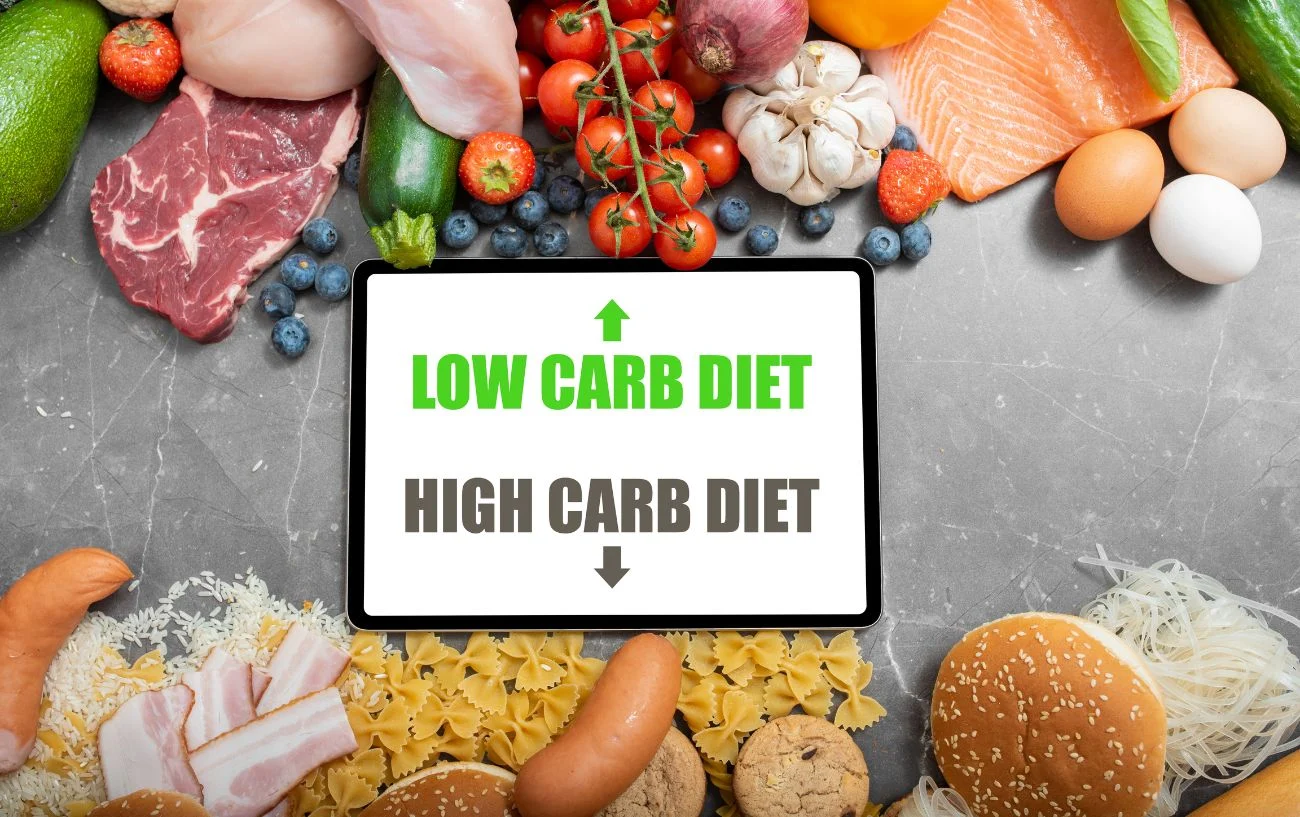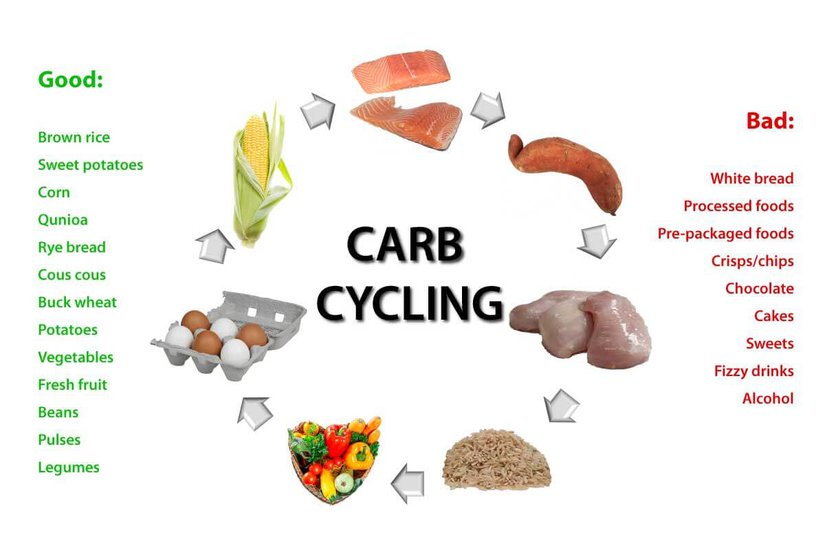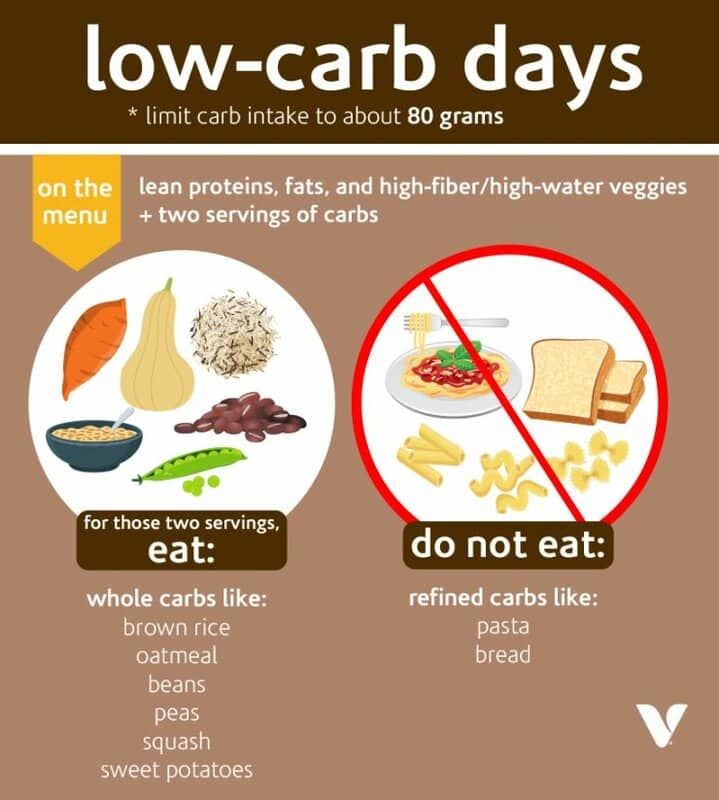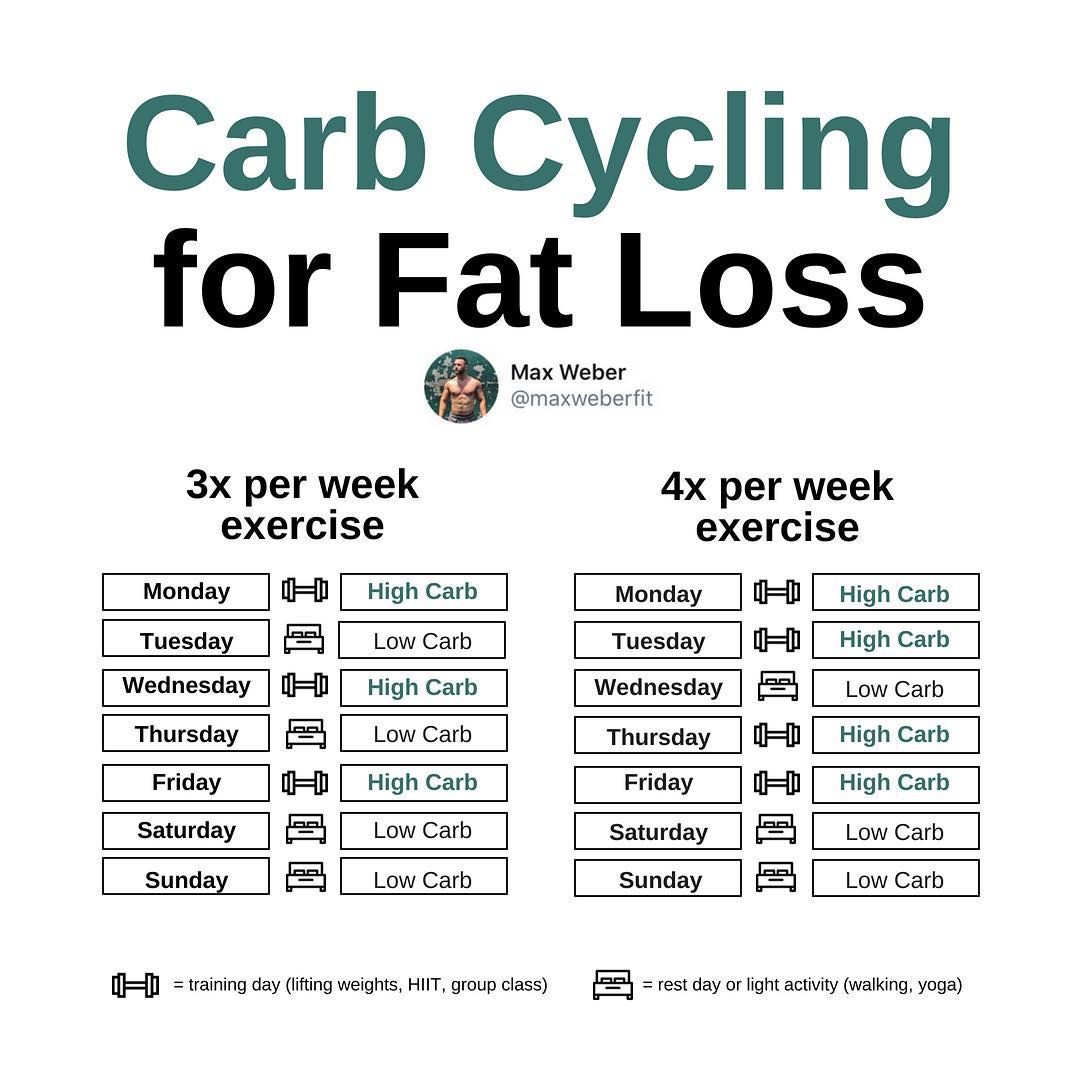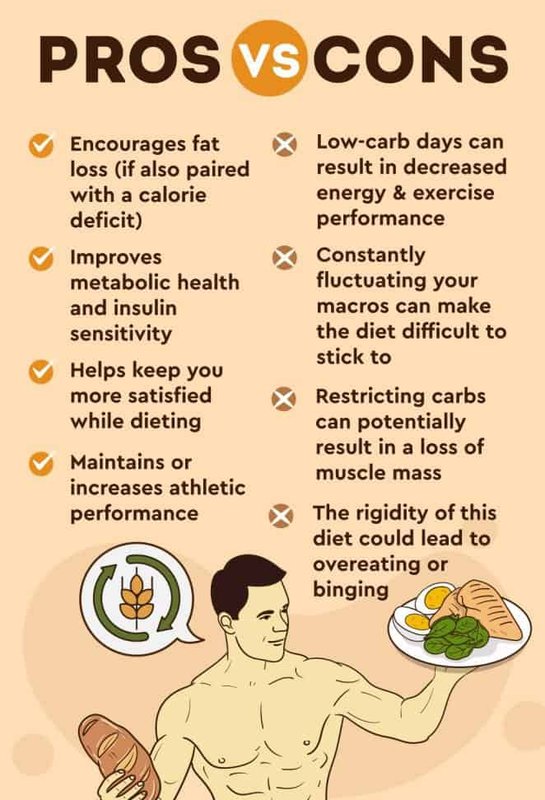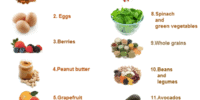Carb Cycling Diet For Weight Loss
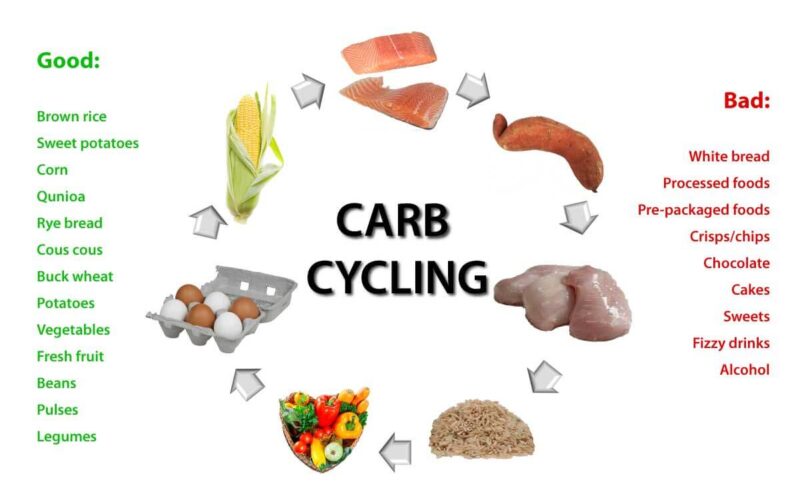
Many people struggle to lose weight, and it can be a difficult process. But what if we told you there’s a diet that could help?
Carb cycling is an effective way for weight loss because it helps to boost your metabolic rate. By varying the amount of carbohydrates you eat each day, your body won’t become accustomed to eating the same number of calories every day. This helps to keep your metabolism running at a higher rate so that you’re burning more calories than usual.
Additionally, by increasing the amount of carbohydrates on certain days, you can also take advantage of glycogen stores in your muscles which will help enhance muscle gain as well as fat loss.
When starting a carb cycling diet for weight loss it’s important to understand how many carbs to eat and when. You’ll need to determine which days are low-carb days and which days are high-carb days in order to maximize the effectiveness of the diet. By following these guidelines and incorporating carb cycling into your lifestyle, you’ll be well on your way to achieving your weight loss goals!
Definition Of Carb Cycling
Carb cycling is a dieting technique that involves alternating amounts of carbohydrates on different days. It’s popular among those looking to lose weight, as it helps control hunger levels and boosts metabolism. On low-carb days, you stick to eating fewer carbs than usual, while on high-carb days, you eat more. By doing this, you can ensure your body gets the right amount of energy on both types of days.
When it comes to weight loss, carb cycling can be beneficial because it helps create an ideal balance between eating enough carbohydrates to provide energy and having enough left over for fat burning. Additionally, by reducing carbs one day and increasing them the next day, you can minimize cravings and maintain a healthy lifestyle. This makes it easier to stick with a diet plan in the long run.
Benefits
The benefits of carb cycling for weight loss are like a treasure trove of jewels. When done correctly, it can be a powerful tool to help you achieve your goals. This diet plan helps to stabilize blood sugar levels and decrease insulin resistance while promoting fat burning and muscle growth. It also forces the body to use stored fat as energy since carbohydrates are limited most days.
By having alternating high-carb and low-carb days, this diet plan allows the body to burn more calories and have a varied intake of nutrients throughout the week. This creates an environment that is conducive to weight loss and improved health overall. Additionally, because it doesn’t involve drastic caloric restrictions, it is easier for people to stick with long term than crash diets or extreme calorie cutting regimens.
Types Of Carb Cycling Diets
Carb cycling is a popular weight loss strategy that involves alternating low-carb days with high-carb days. There are several different types of carb cycling diets, each of which has its own set of rules and guidelines.
The most common type is the traditional carb cycling diet, which consists of five low-carb days followed by two high-carb days. This type of carb cycling can be beneficial for those who are looking to lose weight quickly and safely.
Another type is the targeted carb cycling diet, which uses a more precise approach to carb intake based on the individual’s goals and activity level.
Lastly, there is the cyclical ketogenic diet, which combines intermittent fasting with a very low-carbohydrate diet over a period of several weeks or months.
All three types of carb cycling diets can help individuals reach their health and fitness goals in an effective and sustainable way.
Carb Cycling Mean Plan Example →
Carb Cycling Diet 5/2 Plan
diet plan:
Low Carb Days (5 days):
- Breakfast: 3 eggs, 1 cup of spinach, and 1/2 avocado
- Snack: 1/4 cup of almonds
- Lunch: Grilled chicken salad with mixed greens, cucumber, tomato, and olive oil vinaigrette
- Snack: 1 small apple with 1 tablespoon of almond butter
- Dinner: Grilled salmon with roasted asparagus and 1/2 cup of quinoa
High Carb Days (2 days):
- Breakfast: 1 cup of oatmeal with 1 sliced banana and 1 tablespoon of honey
- Snack: 1/2 cup of berries with 1/4 cup of Greek yogurt
- Lunch: Grilled chicken sandwich on whole-grain bread with lettuce, tomato, and avocado
- Snack: 1 small orange with 1/4 cup of cashews
- Dinner: Grilled sirloin steak with roasted sweet potato and steamed green beans
Cyclical ketogenic diet with low-carbohydrate for several weeks
Low Carb Days (5 days per week):
Note: This diet plan is based on a daily calorie intake of 1500-1800 calories.
- Breakfast: 2 eggs cooked in coconut oil with 1/2 avocado and 1/2 cup of sautéed spinach
- Snack: 1/4 cup of almonds
- Lunch: Grilled chicken salad with mixed greens, cucumber, tomato, and olive oil vinaigrette
- Snack: 1 small apple with 1 tablespoon of almond butter
- Dinner: Grilled salmon with roasted asparagus and 1/2 cup of cauliflower rice
Intermittent Fasting Days (2 days per week):
- 16-hour fast with only water, herbal tea, or black coffee allowed
- Lunch: Grilled chicken or tuna salad with mixed greens, cucumber, tomato, and olive oil vinaigrette
- Snack: 1/4 cup of nuts (almonds, cashews, or walnuts)
- Dinner: Grilled chicken or fish with steamed broccoli and 1/2 cup of cauliflower rice
High Carb Days (2 days per week):
Note: This diet plan is based on a daily calorie intake of 2000-2200 calories.
- Breakfast: 1 cup of oatmeal with 1 sliced banana and 1 tablespoon of honey
- Snack: 1/2 cup of berries with 1/4 cup of Greek yogurt
- Lunch: Grilled chicken sandwich on whole-grain bread with lettuce, tomato, and avocado
- Snack: 1 small orange with 1/4 cup of cashews
- Dinner: Grilled sirloin steak with roasted sweet potato and steamed green beans
On low carb days, aim to consume fewer than 50 grams of carbohydrates per day. On high carb days, aim to consume between 150-200 grams of carbohydrates per day.
Adjust the calorie and carbohydrate intake to fit your individual needs and goals. Additionally, it’s important to consult with a healthcare professional before starting any significant changes to your diet.
Macro-nutrients And Calorie Requirements
Just like a finely tuned car, your body needs the right fuel to get you running at peak performance. When it comes to carb cycling diets for weight loss, understanding your macronutrients and calorie requirements is a key part of the puzzle. Macronutrients are proteins, carbohydrates, and fats that provide energy for our bodies. Consuming adequate amounts of these macronutrients is crucial for keeping our bodies functioning optimally.
In addition to macronutrients, calorie requirements also need to be taken into consideration when following a carb cycling diet for weight loss. Depending on individual goals and lifestyle, calorie intake will vary from person to person. It’s important to listen to your body and adjust your calorie intake accordingly. If you’re feeling fatigued or have difficulty maintaining energy levels throughout the day, it might be time to adjust your calorie intake or consider adding in some extra carbs on certain days.
Understanding how much energy your body needs is an important step towards achieving healthy and sustainable weight loss goals with a carb cycling diet. By determining the right balance of macronutrient intake and caloric demands based on individual needs, weight loss can be achieved without sacrificing bodily functions or overall health.
Food Options
Carb cycling for weight loss involves alternating days of high and low carb intake. On the high carb days, it’s important to choose nutrient-dense foods that will provide energy and help you reach your weight loss goals. On the low carb days, focus on protein-rich foods that will fill you up and create a calorie deficit. Some great food options for a successful carb cycling diet include:
On high-carb days, add whole grains like oatmeal, brown rice, quinoa and barley to your meals. Incorporate fruits such as apples, oranges, bananas and berries into your snacks or breakfast. Legumes like lentils, kidney beans and chickpeas are also great sources of complex carbohydrates. Vegetables like sweet potatoes, carrots and squash can also help you meet your daily carbohydrate needs on these higher-carb days.
On low-carb days, opt for lean proteins such as chicken breast, fish or turkey breast to keep you full throughout the day. Eggs are another great option as they contain both protein and healthy fats. Add in some non-starchy vegetables such as spinach, kale or broccoli for added vitamins and minerals. Nuts like almonds or walnuts provide healthy fats that can help with satiation while providing essential nutrients during the lower-carb days of your cycle.
By incorporating these food options into your carb cycling diet plan you can be sure to meet all of your nutritional needs while still achieving a calorie deficit for successful weight loss results.
Meal Planning Tips
Moving on to meal planning tips for a carb cycling diet, the key is to plan ahead. To make sure you’re getting enough of the right nutrients, it’s important to include a variety of foods, such as lean proteins, healthy fats, and complex carbohydrates. It is also helpful to aim for nutrient-dense foods that are high in vitamins, minerals, and antioxidants.
When planning out meals, try to incorporate at least one serving of vegetables or fruits with each meal. Additionally, it may be beneficial to keep track of your daily macronutrient intake and adjust accordingly if needed.
In terms of timing and frequency of meals, it’s best to eat something every 4-5 hours throughout the day – this helps maintain blood sugar levels and supports better digestion. Eating smaller meals more frequently can also help reduce cravings and keep you feeling fuller longer. Plus, when preparing meals in advance you can ensure that they fit into your carb cycling diet plan.
Exercise Considerations
Exercise plays an integral part in carb cycling for weight loss. As the old saying goes, “it takes two to tango”; diet and exercise must work together to achieve the desired results. It is recommended to do some form of exercise at least three times a week while following a carb cycling diet plan. High-intensity interval training (HIIT) has been shown to be effective in burning fat and maintaining muscle mass. However, it is important to not overdo it when starting out as it can lead to fatigue and injury.
It is especially important for those new to exercise or just starting out on a new program to take extra precaution and begin with light activities like walking, jogging, or even swimming before progressing onto more intense exercises like HIIT workouts. Doing so will help build up strength and endurance safely, allowing for better performance when engaging in more strenuous activities. Additionally, make sure to stretch before and after any type of physical activity as this can help minimize injuries and improve flexibility.
By combining proper nutrition with a consistent exercise regimen tailored specifically for individual needs and goals, carb cycling can be an effective tool in achieving lasting weight loss.
Pros And Cons
Carb cycling is a popular diet for weight loss. It requires strategically timing the number of carbohydrates you consume on a cyclical basis. Here are its pros and cons:
Pros
- Improves insulin sensitivity
- Enhances fat burning
- Makes your body more efficient at utilizing energy
- Can be adjusted for individual needs
Cons
- Can be difficult to follow, as it involves careful planning and record keeping
- Limited research exists on its long term effectiveness
- May require supplementation to ensure adequate nutrient intake
- Potential risk of overexertion due to high intensity workouts that are part of the diet plan
Overall, carb cycling has potential as an effective method of weight loss, though more research is needed to outline its exact benefits and risks. Taking into account individual health factors and lifestyle habits, it’s important to consider all aspects before trying this diet.
How To Make It Work For You
Now that you are aware of the pros and cons of carb cycling for weight loss, let’s look at how you can make it work for your own individual needs. Carb cycling is a flexible diet plan that allows you to personalize macronutrient intakes based on your goals, lifestyle and food preferences. Here we will look at how you can do just that.
| Day | Macronutrients |
|---|---|
| High-carb | 20-30% fat |
| 45-65% carbs | |
| 10-20% protein | |
| Low-carb | 30-40% fat |
| 5-10% carbs | |
| 25-30% protein |
To begin, decide which type of carb cycle best suits your lifestyle. Most commonly used is the 5:2 day ratio with five high carbohydrate days and two low-carb days each week. On high carb days, focus on whole foods like fruits, vegetables, grains and legumes while limiting processed carbohydrates such as white breads and pastries. On low carb days emphasize healthy fats like avocado, olive oil and nuts as well as lean proteins like chicken or fish as outlined in the table above. Additionally, make sure to stay hydrated by drinking plenty of water throughout the day to help manage hunger levels and aid digestion. Lastly, aim for 7 to 9 hours of sleep a night so your body is rested and has time to recover from workouts or other physical activity.
By taking these steps you can create a personalized carb cycling diet plan that works for you! This approach allows for flexibility with both nutrition intake and exercise so you can find what works best for your individual needs while still reaching your desired weight loss goal.
Safety Considerations
When considering any kind of diet, it is essential to consider safety. Carb cycling is no different; although it has many benefits, it’s important to understand the risks associated with such a diet.
For starters, carb cycling requires careful planning and monitoring of food intake. It can be difficult for some people to consistently consume the right amounts of carbohydrates and other macronutrients each day. Additionally, those with certain medical conditions should speak to their doctor before beginning a carb cycling program as some foods may not be recommended for them.
In addition, due to the high-carb days in a carb cycling diet, people may experience bloating or discomfort if they are not used to eating large amounts of carbohydrates or have difficulty digesting them. To avoid this, start slowly and gradually increase your carbohydrate intake as you become more comfortable with the diet. Ultimately, it is important to listen to your body when starting a new diet like carb cycling and adjust accordingly.
Potential Side Effects
Potential side effects of carb cycling diets for weight loss should be considered before beginning the diet. If a person is not used to this type of eating, they may experience slight dizziness or lightheadedness due to temporarily low blood sugar levels. This can usually be fixed by eating a snack that contains some protein and carbohydrates or drinking a glass of juice. It’s also possible that someone may experience digestive issues, such as bloating, cramping, or gas. This could be caused by the sudden switch in macronutrient intake. To prevent this from happening, it’s important to make sure meals are balanced with healthy fats and proteins as well as carbohydrates.
Additionally, there is the potential for nutrient deficiencies if carbs are severely restricted for extended periods of time. To ensure adequate nutrition while on the diet, it’s important to eat a variety of nutritious foods from all food groups and talk to a doctor if any concerning symptoms arise. The key is to find an approach that works best for one’s body and lifestyle while still allowing them to reach their weight loss goals safely.
Alternatives To Carb Cycling
If carb cycling isn’t for you, there are other alternatives to consider. Intermittent fasting is a popular option among dieters looking to lose weight. This plan requires going on a strict fast for 16-20 hours each day and eating all of your meals within a 4-8 hour period. During the fasting period, you can drink calorie-free beverages such as water, tea, or coffee. While intermittent fasting is highly effective for weight loss, it may be difficult to adhere to this plan if you have an active lifestyle.
Another option is the ketogenic diet which focuses on consuming very low levels of carbohydrates and high amounts of fats and proteins. This will put your body into a state of ketosis where it will use fat reserves as energy instead of carbs. The keto diet has been shown to be effective in helping people lose weight quickly, but most individuals find it hard to sustain long term due to its restrictive nature. It’s important to talk with your doctor before starting any diet or exercise program to ensure that it’s safe for you and that it meets your health needs.
What To Expect In Terms Of Results
Now that you know the basics of carb cycling, you may be wondering what kind of results you can expect. Generally speaking, this diet is designed to help reduce overall body fat while maintaining lean muscle mass. This means that you could see a noticeable decrease in your weight without sacrificing any gains in muscle size or strength.
As with any diet, however, it is important to remember that results will vary from person to person. A carb cycling diet may not work for everyone and individuals should consult a doctor before starting any new dietary regimen. Additionally, regular exercise and proper nutrition are key components of maintaining healthy weight loss and should always be part of any successful weight-loss program.
When To Seek Professional Help
It’s estimated that over two-thirds of American adults are considered overweight or obese. With so many people trying to shed excess pounds, it can be difficult to know when to seek professional help for your weight loss goals. While carb cycling can be a helpful tool, there are certain instances in which it’s important to consult with a medical professional before beginning this type of diet.
If you have any pre-existing health conditions, such as diabetes, high blood pressure, or heart disease, it is essential to speak with a doctor prior to starting the carb cycling diet. Additionally, if you are pregnant or breastfeeding, it is wise to consult with a healthcare provider before making any dietary changes. Finally, if you have difficulty following the meal plans and nutrition guidelines required for carb cycling success, it may be beneficial to work with a registered dietitian who can help you find an individualized weight loss plan that works best for your lifestyle.
Frequently Asked Questions
What Is The Recommended Length Of Time To Follow A Carb Cycling Diet?
The recommended length of time to follow a carb cycling diet is largely dependent on individual goals and preferences. This type of diet involves alternating between periods of high and low carbohydrate intake, with the goal of optimizing fat loss while maintaining muscle mass. In order to see the desired results, it is typically suggested to stick with a carb cycling diet for at least three weeks.
After that point, many people find that they are able to maintain their progress by continuing with the same routine or adjusting it as needed. It is also important to note that carb cycling isn’t just about losing weight; it can also be used to improve energy levels and even boost performance in athletes. Therefore, how long someone will need to remain on this type of diet may vary depending on their specific goals and lifestyle.
Ultimately, it’s best to consult with a nutritionist or healthcare provider who can provide personalized advice tailored to an individual’s needs. For most people, starting off by following the diet for several weeks is a reasonable approach in order to assess its effectiveness and benefit from its potential health benefits.
Does Carb Cycling Work For Vegetarians?
Carb cycling has been gaining popularity as a dieting method. But does it work for vegetarians? This article will look at the effects of carb cycling on vegetarian diets, and provide some tips for those considering it.
First, let’s talk about what carb cycling is. Carb cycling is an eating plan that alternates between high-carb and low-carb days, allowing you to still enjoy carbs while dieting. This diet has been associated with weight loss and improved overall health.
To answer the question: yes, carb cycling can work for vegetarians. It can be adapted to fit their dietary preferences, providing them with the same benefits as other people who follow the diet. Here are a few tips to make sure your vegetarian carb cycling experience goes smoothly:
- Make sure you’re getting enough protein: Protein is essential for muscle growth and repair, so make sure you’re getting enough on your low-carb days by eating plant proteins like lentils and tofu.
- Don’t forget about healthy fats: Healthy fats like olive oil and avocados are important for providing energy and keeping you full between meals.
- Plan ahead: Meal planning is important on any diet, but especially when following a vegan or vegetarian one. Planning ahead will help ensure that you have easy access to healthy snacks and meals throughout the day.
Carb cycling offers many potential benefits for vegans and vegetarians alike – from weight loss to improved overall health – so it’s certainly worth considering if you’re looking to improve your diet in any way. With careful planning and adherence to these tips, carb cycling can be a successful addition to any vegetarian lifestyle!
Are There Any Foods To Avoid While Following A Carb Cycling Diet?
As the saying goes ‘you are what you eat’, and following a carb cycling diet for weight loss is no exception. But, are there any foods to avoid while following this diet? The answer is yes. While a carb cycling diet encourages eating healthy carbohydrates, like fruits, vegetables, whole grains and legumes, there are some foods that should be avoided altogether to ensure the effectiveness of the diet.
High-fat processed meats such as pepperoni and salami should be avoided while on a carb cycling diet. These types of meats are high in saturated fat and can cause an increase in cholesterol levels. Additionally, sugary treats like candy bars and cakes have no nutritional value and can easily derail your progress towards your weight loss goal. Refined carbohydrates like white breads, pastas and cereals should also be avoided due to their lack of fiber content which can lead to feeling overly full quickly.
When it comes to maintaining a successful carb cycling diet for weight loss, it is important to remember that not all carbs are created equal. Eating healthy carbohydrates can provide you with the energy needed for exercise, whilst avoiding processed meats, sugary treats and refined carbohydrates will help keep you on track towards achieving your goals.
Is Carb Cycling Suitable For People With Diabetes?
Carb cycling is an eating plan that involves alternating between high- and low-carbohydrate days. It has become popular among people looking to lose weight, but could it be suitable for those with diabetes?
Diabetes is a medical condition in which the body does not properly process glucose, or sugar. Carb cycling, therefore, may seem like an inadequate solution for those with diabetes since it involves fluctuations in carb intake. However, other factors must be considered before determining its suitability. For example, how regularly the individual with diabetes tests their blood sugar levels and how well they are able to manage their insulin dosages would be important considerations.
The most important factor when considering any dietary change for a person with diabetes is to consult a doctor or registered dietician. They will be able to offer advice specific to the individual’s needs and take into account any other health issues that may affect their decision on whether carb cycling is suitable for them.
Are There Any Supplements That Can Be Taken To Support A Carb Cycling Diet?
Carb cycling is like a roller coaster – it takes you on an exciting ride, with many unexpected turns and twists. It’s a popular dieting strategy that involves alternating between high-carb and low-carb days during the week. So, if you’re considering trying out a carb cycling diet for weight loss, are there any supplements that can be taken to support it?
The answer is yes! Depending on your individual needs, there are various supplements that can help support your carb cycling diet. Taking multivitamins, omega-3 fatty acids, magnesium, chromium, and l-carnitine are all great options for increasing nutrient intake and optimizing metabolism when following this diet. Additionally, protein shakes or meal replacements can be consumed on low-carb days to help keep hunger at bay.
In addition to these supplements, make sure you stay hydrated and get enough sleep; both of these factors influence your energy levels and overall health. Eating healthy fats like avocados and nuts can also provide essential nutrients that make up for the lack of carbohydrates in your body during the low-carb phases of the diet. By taking these steps to ensure adequate nutrition during carb cycling, you’ll have greater success in achieving your weight loss goals.
Conclusion
I’ve learned a lot about the Carb Cycling Diet, which seems like a great way to lose weight. It’s a flexible diet that can be tailored to fit any lifestyle, and it’s suitable for vegetarians as well. For those with diabetes, it’s important to talk to your doctor before starting this diet in order to manage blood sugar levels.
Overall, I think Carb Cycling is an excellent choice for those looking for an effective way to reduce their weight. It requires dedication and commitment but with the right attitude and support from friends and family, you can make it work. There are also supplements available that may help you get more out of the diet and speed up your progress.
In conclusion, Carb Cycling is an effective diet plan that can help you reach your weight loss goals while still enjoying some of your favorite foods. With a little bit of planning and preparation, this diet can be adapted to fit into any lifestyle or dietary restriction. So if you’re looking for an easy way to lose weight without giving up all the foods you love, Carb Cycling may be just what you need!
